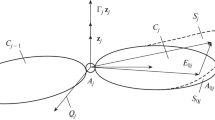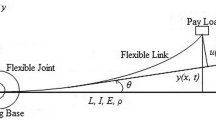Abstract
A computational technique for obtaining the maximum load carrying capacity of robotic manipulators with joint elasticity, subject to accuracy and actuators constraints, is described herein. A feedback linearization technique is used to minimize end-effector deflection. An inversion algorithm is employed for the synthesis of a dynamic feedback control law that provides input-output decoupling and full state linearization. The linearizing input transformations and the corresponding state diffeomorphisms are presented. The proposed technique is then applied to a flexible joint robot. Linearizing control law is been expressed in terms of different sets of model variables and their derivatives. As a result, different tracking errors and torques are introduced in the robot-given trajectory and different load carrying capacities are obtained.
Similar content being viewed by others
References
Sweet LM, Good MC (1985) Redefinition of the robot motion control problem. IEEE Control Syst 5(3):18–24
Rivin E (1988) Mechanical design of robots. McGraw–Hill, New York
De Luca A, Tomei P (1996) Elastic joints. In: Canudas de Wit C, Siciliano B, Bastin G (eds) Theory of robot control. Springer, Berlin Heidelberg New York, pp 179–217
Cesareo G, Nicol‘o F, Nicosia S (1984) DYMIR: a code for generating dynamic model of robots. In: IEEE international conference on robotics and automation, Atlanta, GA
Tomei P (1991) A simple PD controller for robots with elastic joints. IEEE Trans Automat Control 36(10):1208–1213
Spong MW (1987) Modeling and control of elastic joint robots. ASME J Dyn Syst Meas Control 109:310–319
Thomas M, Yuan-Chou HC, Tesar D (1985) Optimal actuator sizing for robotic manipulators based on local dynamic criteria. ASME J Mech Trans Automat Des 107:163–169
Wang LT, Ravani B (1988) Dynamic load carrying capacity of mechanical manipulators – part I: problem formulation. ASME J Dyn Syst Meas Control 110:46–52
Korayem MH, Basu A (1994) Dynamic load carrying capacity of robotic manipulators with joint elasticity imposing accuracy constraints. Robot Autonomous Syst 13:219–229
Spong MW, Vidyasagar M (1989) Robot dynamics and control. Wiley, New York
De Luca A (1996) Decoupling and feedback linearization of robots with mixed rigid/elastic points. In: IEEE international conference on robotics and automation, Minneapolis, MN
Brockett RW (1978) Feedback invariants for nonlinear systems. In: Proceedings of sixth IFAC world congress pp. 1155–1120
Jakubczyk B, Respondek W (1980) On linearization of control systems. Bulletin de l’Academie Polonaise des Sciences, Serie des Sciences Matematyka 28:517–522
De Luca A (1998) A general algorithm for dynamic feedback linearization of robots with elastic joints. In: Proceedings of 37th conference on decision and control, Leuven, Belgium
Slotine JJ, Li W (1991) Applied nonlinear control. Prentice-Hall, New York
Author information
Authors and Affiliations
Corresponding author
Rights and permissions
About this article
Cite this article
Korayem, M., Davarpanah, F. & Ghariblu, H. Load carrying capacity of flexible joint manipulators with feedback linearization. Int J Adv Manuf Technol 29, 389–397 (2006). https://doi.org/10.1007/s00170-005-2525-0
Received:
Accepted:
Published:
Issue Date:
DOI: https://doi.org/10.1007/s00170-005-2525-0




